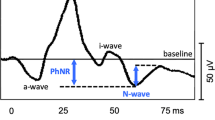Abstract
We report that the human standing potential, measured by the EOG, rises slowly when oxygen saturation is lowered to near 80% by breathing a controlled oxygen-nitrogen mixture. The standing potential falls abruptly by 20–30% of its amplitude when the oxygen saturation returns to 100%. These changes can be generated reproducibly, with minimal discomfort, under conditions that could be adopted for clinical use. Animal experimental studies by Linsenmeier and Steinberg suggest that this hypoxia-hyperoxia response may be a delayed response to potassium concentration changes in the subretinal space. Since there is no requirement for light and no involvement of the Müller cells, the hypoxia-hyperoxia response may be more specific for pigment epithelial pathology than the c-wave.
Similar content being viewed by others
References
Faber DS (1969) Analysis of the slow transretinal potentials in response to light. Ph.D. thesis, State University of New York at Buffalo, N.Y.
Fenn WO, Galambos R, Otis AB and Rahn H. (1949) Corneo-retinal potential in anoxia and acapnia. J Appl Physiol 1: 710–716
Hock PA and Marmor MF. (1983) Variability of the human c-wave. Doc Ophthalmol Proc Ser 37:151–157
Kolder H (1959) Spontane und experimentelle Anderungen des Bestandpotentials des menschlichen Auges. Pflügers Arch 268:258–272
Linsenmeier RA and Steinberg RH. (1984) Mild hypoxia alters K+ homeostasis and pigment epithelial cell membrane responses in the cat retina. Invest Ophthalmol Vis Sci (Suppl) 25:289
Linsenmeier RA, Mines AH and Steinberg RH. (1983) Effects of hypoxia and hypercapnia on the light peak and electroretinogram of the cat. Invest Ophthalmol Vis Sci 24:37–46
Oakley B II (1977) Potassium and the photoreceptor-dependent pigment epithelial hyperpolarization. J Gen Physiol 70:405–425
Taumer R, Wichmann W, Rohde N and Rover J (1976) ERG of humans without c-wave. Graefes Arch Klin Exp Ophthalmol 198:275–289
Yonemura D and Kawasaki K (1979) New approaches to ophthalmic electrodiagnosis by retinal oscillatory potential, drug-induced responses from retinal pigment epithelium and cone potential. Doc Ophthalmol 48:163–222
Author information
Authors and Affiliations
Rights and permissions
About this article
Cite this article
Marmor, M.F., Donovan, W.J. & Gaba, D.M. Effects of hypoxia and hyperoxia on the human standing potential. Doc Ophthalmol 60, 347–352 (1985). https://doi.org/10.1007/BF00158923
Issue Date:
DOI: https://doi.org/10.1007/BF00158923




